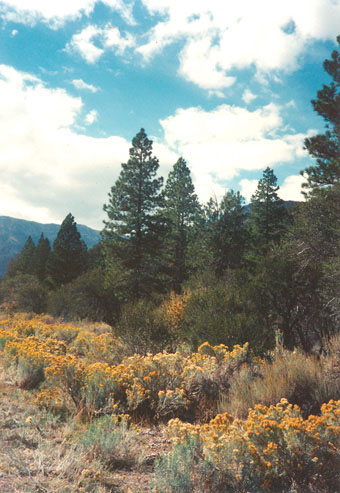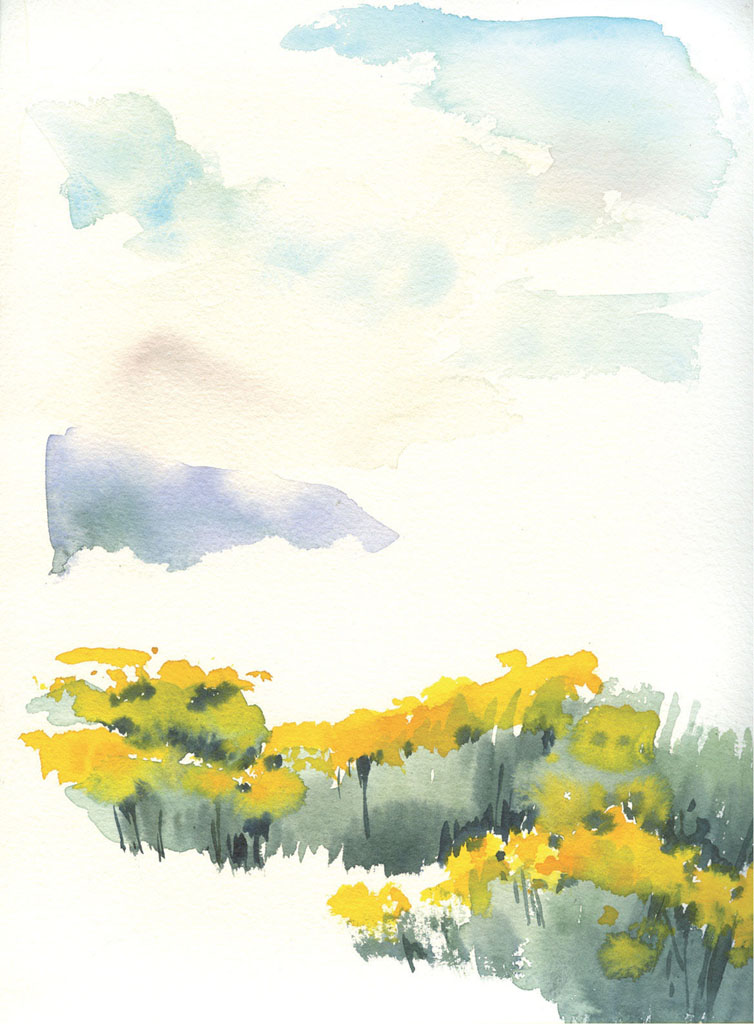
Adding the suggestion of a bird or birds in the sky gives life to your paintings. It’s a very strange day when you see no birds at all.
Wherever you are in the mountains, take a good look to see what makes that particular place unique. What captures its spirit? Mountains and mountain ranges are different. What is it that captures your eye about this particular place?
Fabriano cold-pressed watercolor block
Burnt Sienna, Cadmium Orange, Cadmium Yellow Deep, Manganese Blue Hue, Olive Green, Permanent Rose, Phthalo Blue, Ultramarine Blue, Yellow Ochre
3⁄4-inch (19mm) flat
no. 8 round
old, moth-eaten 1⁄2-inch (13mm) flat
small bristle brush

This is Nevada’s Mt. Charleston, where there is a great range of flora and fauna, as you’ll often find below the tree line. The mountains provide a backdrop to trees, wildflowers and wildlife, making a colorful tapestry. It just cries out to be painted.

Consider the interesting textures to be created with a variety of brushes, old and new. For this painting I chose, from the left, a 3⁄4-inch (19mm) flat, a small bristle brush intended for oil paints, a no. 8 round and a moth-eaten 1⁄2-inch (13mm) flat that’s great for textures. I’m glad I didn’t throw the old moth-eated brush away!

Here is a selection of quick paintings that I did on the spot this past year. From the top: the bare red mountains near Henderson, Nevada; the amazing steep grassy foothills in California, dotted with live oak; the thickly wooded Adirondacks near Lake Durant, New York; and the rugged brown mountains and distant blue vista in the Angeles National Forest, California. Each one is very different from the others.

To keep this scene fresh, lively and immediate, lay in the sky very quickly, with a combination of Phthalo Blue and Manganese Blue Hue and a 3⁄4-inch (19mm) flat, leaving dry-brush edges to suggest the puffy white clouds. While the sky is still damp, add the distant mountain with Ultramarine Blue and a touch of Burnt Sienna, allowing the sky wash to touch, here and there, to suggest low-hanging clouds over the mountaintop.
Quickly lay in the yellow flowers and sage green stems of rabbitbrush with the ratty old 1⁄2-inch (13mm) flat, leaving the upper edge partly white paper for sparkle.

This detail shows the blending between mountain and sky.

A warmer mixture of Yellow Ochre and Phthalo Blue with a bit of Olive Green differentiates the deciduous trees behind the rabbitbrush.

While the trees are still wet, scratch in darker lines to suggest trunks and limbs. Allowing the green washes to dry a bit more will let you scrape the paint back out of the way to look like lighter trunks. Timing is important here, so you may want to practice on scrap paper to get a feel for it.

A shadow wash of mostly Phthalo Blue ties the areas together and softens some parts. The mountain on the right is Ultramarine Blue with Yellow Ochre and a little Phthalo Blue, kept very simple but varied a bit to suggest the trees that cling to the slopes.
Some spatter, some more pouncing strokes with that little bristle brush and a few detailed stems painted with the tip of the no. 8 round finish the flowers and foreground.

Paint in the lacy evergreens mostly using that handy old bristle brush. Use a pouncing and sometimes scratching motion and a strong mixture of Phthalo Blue and Burnt Sienna, again scraping and scratching through the damp paint to suggest limbs.
With the no. 8 round, paint the more distant trees to the left using a dancing motion of the tip. Keep them a bit lighter and cooler in value to push them into the distance.